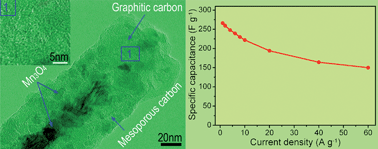In this paper, using manganese oxide as an example, we report the successful design and synthesis of a novel one-dimensional highly graphitic carbon-tipped manganese oxide/mesoporous carbon/manganese oxide hybrid nanowire. The unique structure significantly improves the conductivity of metal oxide materials, which is a key limitation in pseudocapacitors. The hybrid nanowire with optimal carbon content, when applied as an electrode, exhibits superior capacitive properties in 1 M Na2SO4 aqueous solution, such as high specific capacitance (266 F g−1 at 1 A g−1), excellent rate capability (56.4% capacity retention at 60 A g−1) and outstanding cycling stability (without degradation after 1200 cycles). The energy densities achieved can be as high as 20.8 W h kg−1, at a power density of 30 kW kg−1. The results demonstrated that the manganese oxide in our hybrid nanomaterial was efficiently utilized with the assistance of the highly conductive graphitic carbon-tipped mesoporous carbon shell. It is reckoned that the present low-cost novel hybrid nanowire can serve as a promising electrode material for supercapacitors and other electrochemical devices.

You have access to this article
 Please wait while we load your content...
Something went wrong. Try again?
Please wait while we load your content...
Something went wrong. Try again?


 Please wait while we load your content...
Please wait while we load your content...